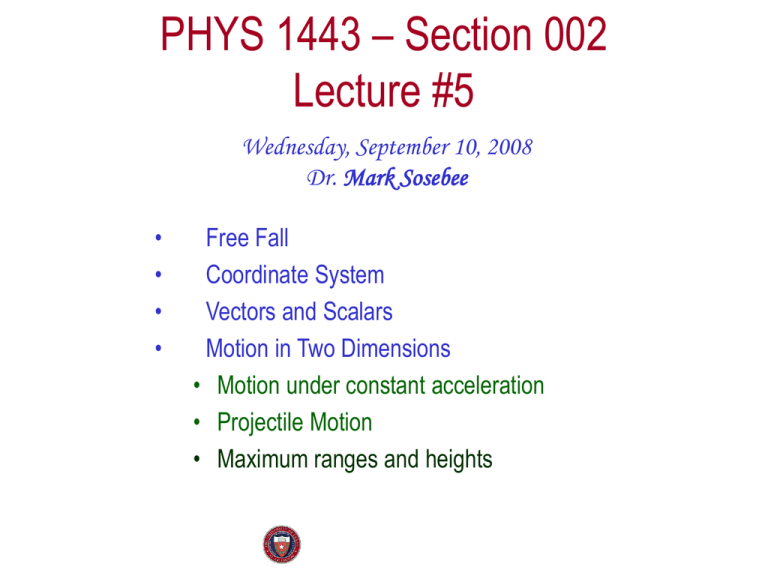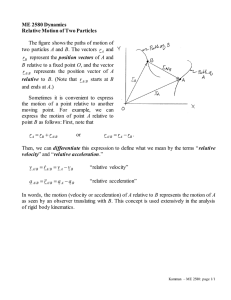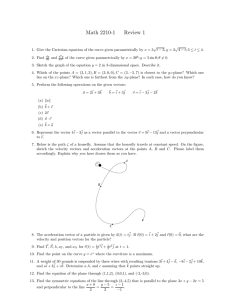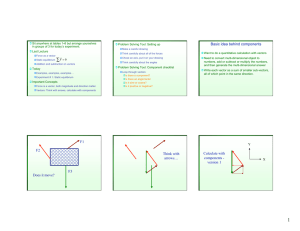Wednesday, Sept. 10 , 2008
advertisement

PHYS 1443 – Section 002 Lecture #5 Wednesday, September 10, 2008 Dr. Mark Sosebee • • • • Free Fall Coordinate System Vectors and Scalars Motion in Two Dimensions • Motion under constant acceleration • Projectile Motion • Maximum ranges and heights Announcements • The first term exam is to be next Wednesday, Sept. 17 – Will cover CH1 – what we finish today (likely to be CH3) + Appendices A and B – Mixture of multiple choices and essay problems – In class, from 1 – 2:20pm, SH103 – Jason will conduct a review in the class Monday, Sept. 15 • There will be a department colloquium this afternoon at 4pm in SH101 – Extra credit – Be sure to sign in – Refreshment at 3:30pm in SH108, the Physics Lounge! Wednday, Sept. 10, 2008 PHYS1443-002-Fall 2008 Dr. Jaehoon Yu 2 Wednday, Sept. 10, 2008 PHYS1443-002-Fall 2008 Dr. Jaehoon Yu 3 Coordinate Systems • They make it easy and consistent to express locations or positions • Two commonly used systems, depending on convenience, are – Cartesian (Rectangular) Coordinate System • Coordinates are expressed in (x,y) – Polar Coordinate System • Coordinates are expressed in distance from the origin ® and the angle measured from the x-axis, q (r,q) • Vectors become a lot easier to express and compute +y How are Cartesian and Polar coordinates related? y1 (x1,y1) =(r1,q1) r1 x1 r1 cos q1 r x12 y12 1 q1 O (0,0) Wednday, Sept. 10, 2008 x1 +x y1 r1 sin q1 PHYS1443-002-Fall 2008 Dr. Jaehoon Yu y1 tan q1 x1 y1 x 1 q1 tan 1 4 Example Cartesian Coordinate of a point in the xy plane are (x,y)= (-3.50,-2.50)m. Find the equivalent polar coordinates of this point. y q qs (-3.50,-2.50)m 2 y2 3.50 2 2.50 2 18.5 4.30( m) x r x r q 180 q s tan q s 2.50 5 3.50 7 1 5 q s tan 35.5 7 o o o q 180 q s 180 35.5 216 Wednday, Sept. 10, 2008 PHYS1443-002-Fall 2008 Dr. Jaehoon Yu o 5 Vector and Scalar Vector quantities have both magnitudes (sizes) and directions Force, gravitational acceleration, momentum ur Normally denoted in BOLD letters, F, or a letter with arrow on top F Their sizes or magnitudes are denoted with normal letters, F, or ur absolute values: F or F Scalar quantities have magnitudes only Can be completely specified with a value and its unit Normally denoted in normal letters, E Energy, heat, mass, time Both have units!!! Wednday, Sept. 10, 2008 PHYS1443-002-Fall 2008 Dr. Jaehoon Yu 6 Properties of Vectors • Two vectors are the same if their sizes and the directions are the same, no matter where they are on a coordinate system!! Which ones are the same vectors? y D A=B=E=D F A Why aren’t the others? B x E Wednday, Sept. 10, 2008 C PHYS1443-002-Fall 2008 Dr. Jaehoon Yu C: The same magnitude but opposite direction: C=-A:A negative vector F: The same direction but different magnitude 7 Vector Operations • Addition: – Triangular Method: One can add vectors by connecting the head of one vector to the tail of the other (head-to-tail) – Parallelogram method: Connect the tails of the two vectors and extend – Addition is commutative: Changing order of operation does not affect the results A+B=B+A, A+B+C+D+E=E+C+A+B+D A+B B A • A = B A+B OR A+B B A Subtraction: – The same as adding a negative vector:A - B = A + (-B) A A-B • -B Since subtraction is the equivalent to adding a negative vector, subtraction is also commutative!!! Multiplication by a scalar is increasing the magnitude A, B=2A Wednday, Sept. 10, 2008 B 2A A PHYS1443-002-Fall 2008 Dr. Jaehoon Yu B=2A 8 Example for Vector Addition A car travels 20.0km due north followed by 35.0km in a direction 60.0o west of north. Find the magnitude and direction of resultant displacement. r Bsinq N B 60o Bcosq r q 20 A 2 B sin q 2 A2 B 2 cos 2 q sin 2 q 2 AB cosq A2 B 2 2 AB cosq 20.02 35.02 2 20.0 35.0 cos 60 2325 48.2(km) E B sin 60 q tan 1 tan 1 35.0 sin 60 20.0 35.0 cos 60 30.3 38.9 to W wrt N 37.5 tan 1 Wednday, Sept. 10, 2008 A B cosq A B cos 60 PHYS1443-002-Fall 2008 Dr. Jaehoon Yu Find other ways to solve this problem… 9 Components and Unit Vectors Coordinate systems are useful in expressing vectors in their components y (+,+) Ay A (-,+) (Ax,Ay) q (-,-) u r A (+,-) Wednday, Sept. 10, 2008 ur A cos q Ax 2 Ax ur A cos q Ay ur A sin q x A Ax Ay 2 ur A sin q u r 2 A cos 2 q sin 2 q PHYS1443-002-Fall 2008 Dr. Jaehoon Yu 2 } Components } Magnitude 2 u r A 10 Unit Vectors • Unit vectors are the ones that tells us the directions of the components • Dimensionless • Magnitudes are exactly 1 • Unit vectors are usually expressed in i, j, k or r r r i, j, k So the vector A can be re-written as Wednday, Sept. 10, 2008 r ur ur r ur r r A Ax i Ay j A cos q i A sin q j PHYS1443-002-Fall 2008 Dr. Jaehoon Yu 11 Examples of Vector Operations Find the resultant vector which is the sum of A=(2.0i+2.0j) and B =(2.0i-4.0j) r r r r ur ur ur C A B 2.0i 2.0 j 2.0i 4.0 j r 2.0 2.0 i ur C 4.0 2.0 2 r 2.0 4.0 j r r 4.0i 2.0 j m 2 16 4.0 20 4.5(m) q 2.0 tan tan 27o Cx 4.0 1 Cy 1 Find the resultant displacement of three consecutive displacements: d1=(15i+30j +12k)cm, d2=(23i+14j -5.0k)cm, and d3=(-13i+15j)cm ur ur ur ur r r r r r r r r D d 1 d 2 d 3 15i 30 j 12k 23i 14 j 5.0k 13i 15 j r r r r r r 15 23 13 i 30 14 15 j 12 5.0 k 25i 59 j 7.0k (cm) Magnitude Wednday, Sept. 10, 2008 ur D 25 59 7.0 65(cm) 2 2 PHYS1443-002-Fall 2008 Dr. Jaehoon Yu 2 12 Displacement, Velocity, and Acceleration in 2-dim • Displacement: • Average Velocity: • Instantaneous Velocity: • Average Acceleration • Instantaneous Acceleration: Wednday, Sept. 10, 2008 r r r r r f r i r r r r r f ri r v t f ti t r r r r dr v lim t 0 t dt r r r r v f vi v a t f ti t How is each of these quantities defined in 1-D? r r r r 2 r v dv d d r d r a lim 2 dt dt t 0 t dt dt PHYS1443-002-Fall 2008 Dr. Jaehoon Yu 13 Kinematic Quantities in 1D and 2D Quantities Displacement Average Velocity 1 Dimension 2 Dimension r r x x f xi vx r r r r r r f r i v t t f ti x f xi x t t f ti Inst. Velocity x dx v x lim t 0 t dt Average Acc. v x v xf v xi ax t t f ti Inst. Acc. What is Wednday, Sept. 10, 2008 r r r f ri r r r r d r v lim t 0 t dt r r r r v v f vi a t t f ti r r r 2 vx dvx d x r v dv d r a x lim 2 a lim 2 t 0 t t 0 t dt dt dt dt 2 the difference between 1D2008 and 2D quantities? PHYS1443-002-Fall Dr. Jaehoon Yu 14 2-dim Motion Under Constant Acceleration • Position vectors in x-y plane: r r r rf x f i y f j r r r ri xi i yi j • Velocity vectors in x-y plane: r r r vi vxi i v yi j r r r v f vxf i v yf j Velocity vectors in terms of the acceleration vector X-comp v xf vxi axt Y-comp v yf v yi a y t r r r r r r r v f vxi axt i v yi a yt j vxi i v yi j ax i a y j t r r vi at Wednday, Sept. 10, 2008 PHYS1443-002-Fall 2008 Dr. Jaehoon Yu 15 2-dim Motion Under Constant Acceleration • How are the 2D position vectors written in acceleration vectors? Position vector components Putting them together in a vector form Regrouping the above Wednday, Sept. 10, 2008 1 2 x f xi vxi t ax t 2 r r r rf x f i y f j 1 2 y f yi v yi t a y t 2 r r 1 1 2 2 xi vxit axt i yi v yit a yt j 2 2 r 2 r r r r 1 r xi i yi j vxi i v yi j t ax i a y j t 2 r r 1r 2 ri vit at 2D problems can be 2 interpreted as two 1D PHYS1443-002-Fall 2008 Dr. Jaehoon Yu problems in x and y 16 Example for 2-D Kinematic Equations A particle starts at origin when t=0 with an initial velocity v=(20i-15j)m/s. The particle moves in the xy plane with ax=4.0m/s2. Determine the components of the velocity vector at any time t. vxf vxiaxt 20 4.0t m / s v yf v yi a y t 15 0t 15 m / s Velocity vector r r r r r v t vx t i v y t j 20 4.0t i 15 j ( m / s ) Compute the velocity and the speed of the particle at t=5.0 s. r r r r r r r vt 5 vx,t 5i v y ,t 5 j 20 4.0 5.0 i 15 j 40i 15 j m / s r speed v Wednday, Sept. 10, 2008 vx 2 vy 2 40 PHYS1443-002-Fall 2008 Dr. Jaehoon Yu 2 15 43m / s 2 17 Example for 2-D Kinematic Eq. Cnt’d Angle of the Velocity vector vy q tan vx 1 1 15 1 3 o tan tan 21 40 8 Determine the x and y components of the particle at t=5.0 s. 1 2 1 x f vxi t ax t 20 5 4 52 150( m) 2 2 y f v yi t 15 5 75 (m) Can you write down the position vector at t=5.0s? r r r r r r f x f i y f j 150i 75 j m Wednday, Sept. 10, 2008 PHYS1443-002-Fall 2008 Dr. Jaehoon Yu 18 Projectile Motion • A 2-dim motion of an object under the gravitational acceleration with the following assumptions – Free fall acceleration, g, is constant over the range of the motion r r • g 9.8 j m s 2 – Air resistance and other effects are negligible • A motion under constant acceleration!!!! Superposition of two motions – Horizontal motion with constant velocity ( no acceleration ) – Vertical motion under constant acceleration ( g ) Wednday, Sept. 10, 2008 PHYS1443-002-Fall 2008 Dr. Jaehoon Yu 19 Show that a projectile motion is a parabola!!! x-component vxi vi cos q v yi vi sin qi y-component a axi a y j gj ax=0 x f vxi t vi cos qi t t xf vi cosq i In a projectile motion, the only acceleration is gravitational one whose direction is always toward the center of the earth (downward). 1 2 1 2 v sin q t gt y f v yi t g t i i 2 2 Plug t into the above xf xf 1 y f vi sin qi 2 g v cos q i i vi cos qi g y f x f tan q i 2 2 2 v cos qi i Wednday, Sept. 10, 2008 PHYS1443-002-Fall 2008 Dr. Jaehoon Yu 2 x f 2 What kind of parabola is this? 20 Projectile Motion Wednday, Sept. 10, 2008 ThePHYS1443-002-Fall only acceleration in this 2008 Dr. Jaehoon motion. It isYua constant!! 21 Example for Projectile Motion A ball is thrown with an initial velocity v=(20i+40j)m/s. Estimate the time of flight and the distance the ball is from the original position when landed. Which component determines the flight time and the distance? 1 y f 40t g t 2 0m 2 Flight time is determined by the y component, t 80 gt 0 because the ball stops moving when it is on the ground after the flight. So the possible solutions are… Distance is determined by the x component in 2-dim, because the ball is at y=0 position when it completed it’s flight. Wednday, Sept. 10, 2008 80 t 0 or t 8 sec g Why isn’t 0 t 8sec the solution? x f vxi t 20 8 160 m PHYS1443-002-Fall 2008 Dr. Jaehoon Yu 22




